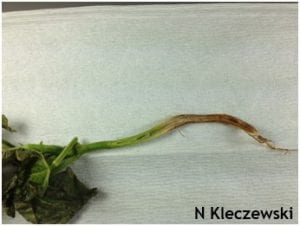Nathan Kleczewski, Extension Specialist – Plant Pathology; nkleczew@udel.edu
Fusarium foot rot or dry rot (FDR) of beans is commonly found in fields where beans are grown worldwide. FDR does not often result in significant yield losses, and damage is negligible in vigorously growing, stress-free plants. This disease can be part of a root rot complex along with Rhizoctonia and Pythium. This year we have seen instances of both the root-rot complex as well FDR in snap beans. In the field plants may appear wilted, yellow, or stunted. Typically these symptoms are not apparent until 14-21 days after planting. If symptomatic plants are uprooted, the root system may be decayed and brown/red-brown lesions may be apparent on the taproots (Figure 1). As the disease progresses, the cortex becomes red/brown and the lower stem can become hollow and have a corky texture (Figure 2). The internal portions of the stem may be filled with white/pink fungal growth. In some cases, particularly under high moisture environments, plants may develop adventitious roots along the soil surface.
 Figure 1. Snap beans with brown/red roots presenting symptoms of root rot
Figure 1. Snap beans with brown/red roots presenting symptoms of root rot
 Figure 2. A snap bean sliced to show hollowing of tap root and presence of white/pink fungal mycelia
Figure 2. A snap bean sliced to show hollowing of tap root and presence of white/pink fungal mycelia
FDR grows in/on soil residue, and produces thick-walled resting spores that allow it to survive in soils for extensive periods of time. Although the pathogen that causes FDR can grow on residue of, for example, corn, it only causes disease on beans. Any factor that reduces root growth can increase FDR incidence and severity. Examples of these factors include low soil temperatures, nutrient stress, soil compaction, flooding, drought, and injury caused by cultivation, herbicides, or fertilizer.
The following management practices should be considered in FDR is/has been an issue for you:
● Plant beans into warm soils. When soil temperatures are 68°F and higher, levels of FDR are negligible.
● Deep plow to invert bean residue and promote tissue decomposition
● If possible, rotate away from beans (including soybean) for 3 years or more.
● Avoid soil compaction
● Avoid damaging roots via cultivation. Wounds provide easy entry sites for Fusarium as well as other root infecting pathogens.
● Manage water to avoid water excess or deficiency
● Maintain adequate nutrient levels
● Use FDR-tolerant varieties. No bean line is immune to this disease.
